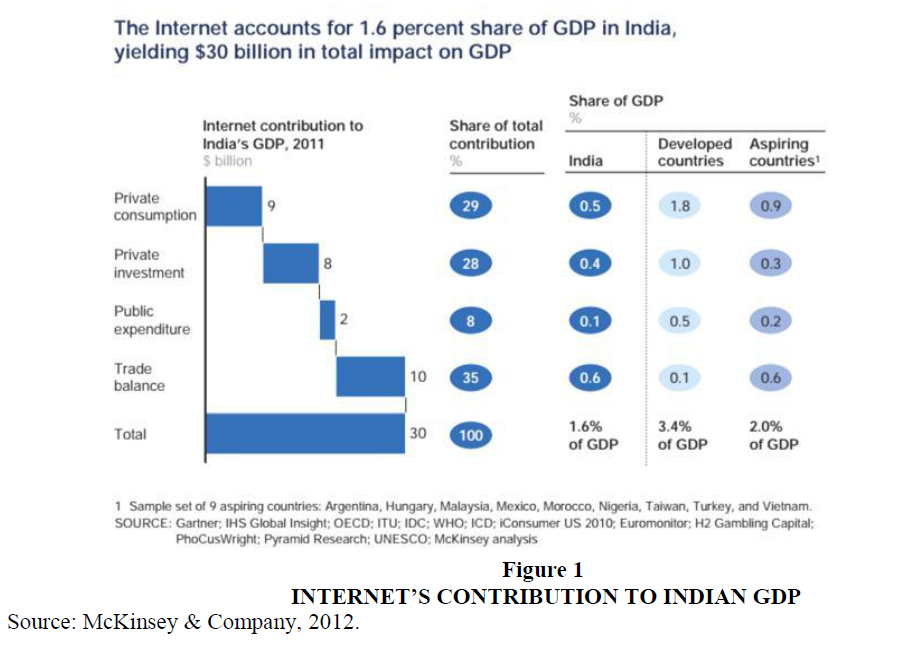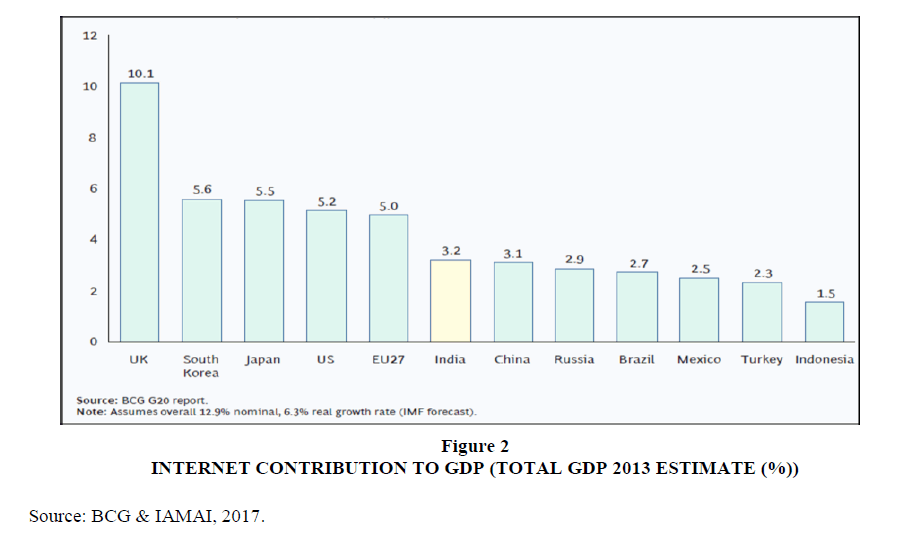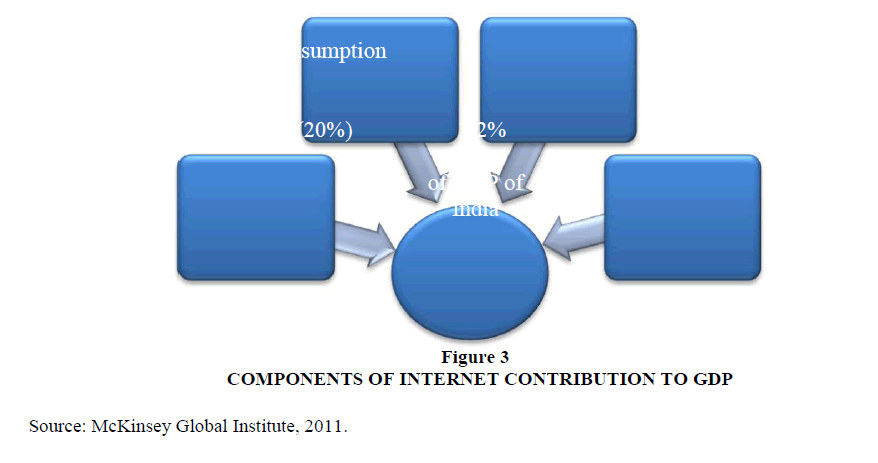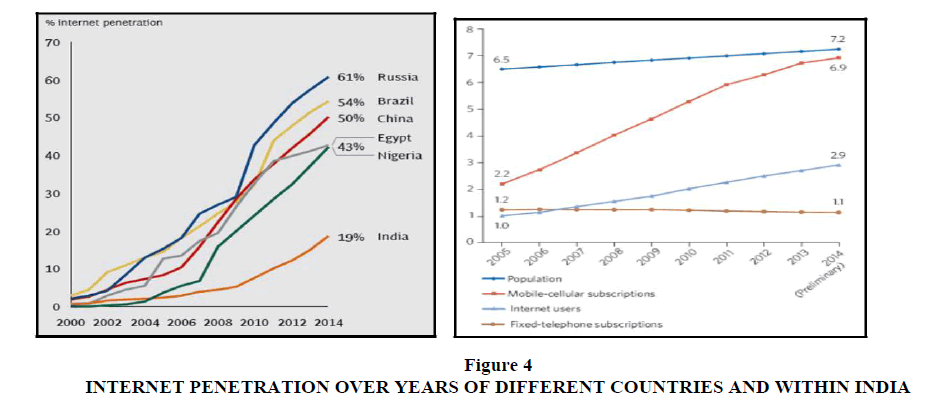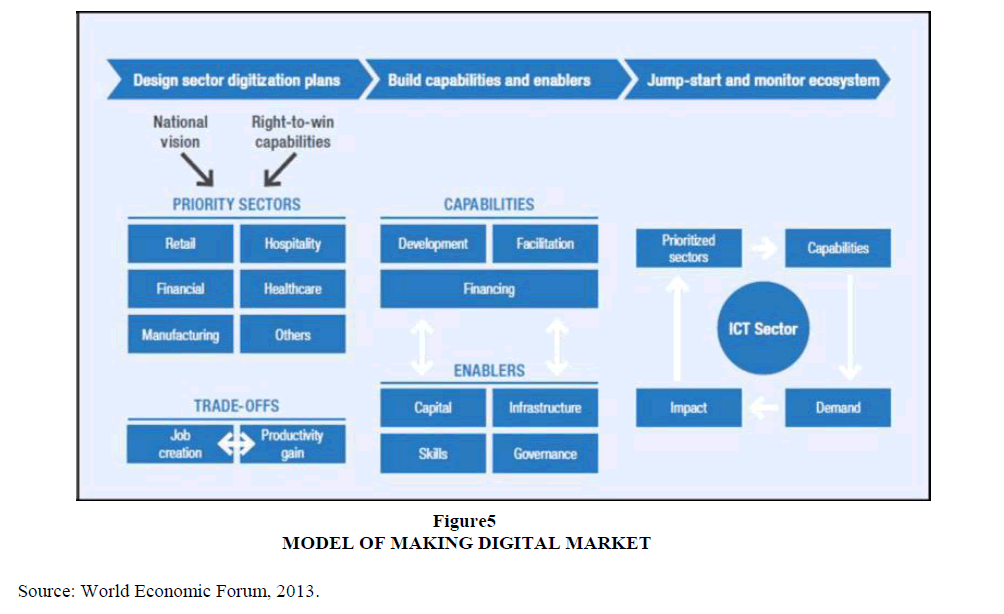Research Article: 2021 Vol: 25 Issue: 6
Influence of Technology and E- Commerce on Economic Growth: Some Evidence from Indian Economy
Roop Lal Sharma, Assistant Professor, Shri Mata Vaishno Devi University, Katra, Jammu
Ajay Kumar Sharma, Research Scholar, Shri Mata Vaishno Devi University, Katra, Jammu
Citation: Sharma., R.L. & Sharma, A.J. (2021). Influence of technology and e- commerce on economic growth: some evidence from indian economy. Academy of Marketing Studies Journal, 25(6), 1-10.
Abstract
Keywords
Technology, Economic Growth, E-Commerce, Employment, Internet Penetration.
Introduction
Emergence of technology followed by proliferation of e-commerce has profound impact on the productivity and socio-economic standard of the society. Evolution of technology and associated information and knowledge help establish society’s production capacity and standard of living which are decisive to the economic growth of the nation (Pohjola, 2001), (M. Castells, 2000). Being a global concept, digitization has prominent impact on economic growth and employment of any nation. In a study, digitization index has been linked to higher growth and employment with increasing returns to scale. Human capital is a key component to the impact of digitization (Katz, Koutroumpis, & Callorda, 2014).
In order to take advantage of e-commerce business, there has to be a proper business model as well as other strategies so that the business is sustainable and provides economic growth (Mafe & Blas, 2006). Domestic policies regarding telecommunication, financial services and distribution and delivery would provide inputs for e-commerce trade related negotiations. Research show developing economies has more possibilities of gaining advantages of e-commerce than the developed economies as developing economies have wider scope of reducing inefficiencies and increase production (Mirmiran & Shams, 2014).
Indian economy has seen unprecedented growth of e-commerce in the last 5 years. Increasing internet penetration, rapid technology adoption and high sale of technical gadgets like smartphones, tablets, etc., have led to an attractive online customer base. Digitization has brought social transformation in the life of common Indians.
The present government has taken up an initiative called “Digital India” for modernization of the society that will connect every corner of the country. However, the effect of digitization at macro level in Indian economy is yet to be revealed. With the enormous benefits of digitization come political challenges for the policymakers to set the stage for seamless digitization. Studies reveal that use of internet by Indian SMEs would fetch 32% more revenue and 37% higher employment (FICCI & Nathan Associates Inc, 2013).
Objectives
The objective of the paper is to seek answers from the following questions.
- How is technology fostering economic growth of the nations?
- What is the contribution of internet and e-commerce towards the GDP of a country?
- What type of employment opportunities are created by technology and e-commerce in particular and how these opportunities could be leveraged in India?
Review of Literature and Research Findings
Digitization, from societal perspective, has been defined as “the economic and social transformation triggered by the massive adoption of digital technologies to generate, process, share and transact information” (Katz, et al. 2014). It is emerging to be the key economic driver of recent time as it provides economic growth and helps in job creation (World Economic Forum, 2013). Few years back when the world economy was sluggish, digitization boosted it with $193 billion output and were able to create 6 million jobs round the globe (World Economic Forum, 2013). World Economic Forum (2013) mentioned in its report that 10% increase in digitization score of any country would bring 0.75% growth in its GDP per capita. Other studies confirm that its impact is 4.7 times more than the average impact of 0.16% on the per capita GDP for broadband deployment in Figure 1 (World Economic Forum, 2013).
The world economy has been changed since the development of information and communications technology (ICT). The major portion of business world has been transformed to e-business with the dramatic penetration of internet and its acceptance by the backend supply chain partners and end consumers. E-commerce or Ebusiness can be referred to be the activity that occurs within the electronic market (Turban, Lee, King, & Chung, 2000). Various research have explored the benefits of ICT in the ebusiness arena. Enhancement of efficiency along with cost cutback (Fink, 1998), improvement in business performance and responsiveness (Venkatraman, 1994) and increased competitiveness (Blili & Raymond, 1993) are among the few boons of ICT that has been prominently visible in e-commerce since last decade in Figure 2.
Economy is able to derive three folded benefits from e-commerce in terms of firms, prices and productivity (Terzi, 2011). E-commerce companies have mastered the art of electronic transactions and overcome the inefficiencies of coordination among supply chain partners to optimize their operation and streamlined their production process by incorporating third parties to become more competitive. The empirical evidence on price give a mixed review of high and low price elasticity of demand (Degeratu, Rangaswamy, & Wu., 1998), (Goolsbee, 1998). It has been found that development of ICT provides sustainable escalation in productivity (Terzi, 2011). Studies found that contribution of ICT towards economic growth of OECD countries rose from 0.5% to 0.9% in late 90s and grew consistently over the years (Colecchia & Schreyer, 2001). The maximum effect of ICT was in United States followed by Australia, Finland and Canada (Colecchia & Schreyer, 2001).
In a report of a research firm McKinsey it has been found in large economies internet accounts for about 3.4% of GDP on average. These economies constitute 70% of the world economy (McKinsey, 2011). Internet consumption and expenditure is found to be more than agricultural sector, if considered as separate sector. Global contribution of Internet equals the GDP of Spain and Canada (McKinsey, 2011). From several research it has been found that United States was able to improve labor efficiency and capital with the help of ICT (Oliner & Sichel, 2000). In an empirical study it was found that development of e-commerce of China let the development of Chinese logistics industry. Both these industries together in turn contributed to the economic growth of the country (Huirong, 2014). Another empirical research studied B2B e-commerce and GDP of U.S., Japan, Germany, Britain and France to find 0.25% annual increase in GDP (basis 2000-2010) in all these countries for B2B e-commerce (Brookes & Wahhaj, 2000). Another research proposed from microscopic point that with the ability to reduce transaction cost and improve economic efficiency, e-commerce can contribute to economic growth (Xiaohong, 2011). In 2002 Cisco Systems study showed that popularity of e-commerce resulted in average productivity growth of 2.1% from 1.2% in the US in between 1995 to 2000. Again, in EU, e-commerce helped productivity grew from 0.3% to 1.7% in the period 2000-2010 (Huirong, 2014).
Effect of Digitization: E-commerce boom and Employment opportunities
Both developed and developing economies are reaping benefits for digitization. Researchers say developed countries are trading higher economic benefits from digitization, although job creation is more in the developing countries. The developed countries have measurable effects of growth for digitization as they depend on domestic consumption making non-tradable sectors important. However, they outsource lower skilled work to emerging markets for cheaper labor. Developing countries, on the other hand, focuses more on exports and tradable sectors. Thus, for them gains come from the effect of digitization on employment rather than from its influence on growth (World Economic Forum, 2013). The 6 million jobs that were created by the digitization effects were found to be 94% from emerging economies and 6% from North America and Western Europe. According to the World Economic Forum (2013) a country which gains 10 digitization score, reduces unemployment by 1.02 per cent (World Economic Forum, 2013).
Studies have shown that a complex set of interactive forces would determine the effect of e-commerce on employment and wages (Terzi, 2011). E-commerce provides opportunity for direct and indirect employment on one hand and on other it is also responsible for job losses. ICT related jobs would be boosted as demands for computers and information system managers, computer system analysts, computer engineers, computer support specialists, database administrators, computer scientists and computer programmers would increase. In addition to this artist and commercial artists, designers and writers and editors would also be in demand (Singh, 2008).
Internet has been able to create 3.6 million jobs in the United States. This is more than the workforce engaged in agriculture and construction combined in the country (Castelao, 2012). In a European Commission press release, it mentions that 500000 jobs were created in the US in last 5 years for the development of mobile application and IT related (European Commission, 2012), (ITIF, 2013). British business has been equally influenced by the digital wave. A recent study in Britain reported that 7,45,000 more digitally skilled workers are required to let the economy grow. The digital space is creating more jobs for UK than they can fill it (Grech, 2014). With the thriving digital ecosystem, UK has been able to employ 1.46 million people in digital companies. In addition to this, it has been forecasted that digital employment would grow by 5.4% by 2020 (Tech City, 2015). An extensive study in France showed that 2.6 jobs are created on every job destroyed by internet. Analyzing 15 years, the report found that 1.2 million jobs were created by the internet and there was a loss of 5, 00,000 jobs (McKinsey Global Institute, 2011), (ITIF, 2013). In Nigeria, a developing country, where e-commerce is at a nascent stage generated 50000 jobs. As the e-commerce industry expands in Nigeria, opportunities are increasing for web designers, logistics personnel and affiliated services. Nigerian Ministry of Communications Technology quoted in 2012 e-commerce has created 12000 jobs for the country. As the e-commerce rise steeply there, 60% of the jobs advertised online comes from the e-commerce category (Vanguard, 2015). In a press release by European Commission, it is mentioned that online business is expected to contribute to 20% growth and net job creation for European Union (European Commission, 2012). In 2013 there were 650,000 websites of B2C online shops in Europe and was expected to grow by 15-20% based on the present online penetration. It has been estimated that this would create 2 million jobs directly and indirectly (Europe E-commerce, 2014).
With the growth of digital industries, the demand for digital skills would also increase. Companies would be looking out for coders, web developers, product managers and data scientists who would be steering the business to grow. There would also be requirement of online marketing managers, product developers and user-experience experts also. Continuous innovation and creative thinking would be required for facing the challenges of the digital business world (Jones, Beynon-Davies, & Muir, 2003). Potential of India’s SME markets is depicted in the following Figure 3.
Implications and Suggested Strategies for Digitization of Indian Economy
Digitization of the economy is the future. There is no looking back on that. In order to make the economic growth move through an upward trajectory, it is important for the government, business fraternity, education system and the people to realize that embracing the changing technology would help the country and its people to grow and remain competitive. Studies show that in last five years internet contributed 21% to the economic growth of the matured economy (McKinsey Global Institute, 2011). However, internet’s contribution toward GDP growth of India was 5%.

Globally, usage of internet was found to grow businesses across sectors in double the speed compared to the non-users. SME Enterprises that use internet were able to create more jobs and earned more revenue. The McKinsey survey (2011) showed profitability is increased by 10% on an average across countries due to internet. Higher penetration of internet has manifold impact on any country’s economy. Its impact primarily moves around two components: consumption & expenditure and supply. The consumption and expenditure is the usage by individuals, companies and government. The supply side includes the industries like telecommunication, hardware manufacturers, software and services that shape the internet world. The consumption and expenditure side of internet impact in India is exhibited in the above Figure 4. The trade balance is the maximum contributor to the GDP which involves business over internet. This provides an opportunity for the Indian economy to earn more revenue by expanding exports and boost economic growth which in turn would create employment opportunities. Public expenditure towards internet spending is relatively low as compared to the mature digital markets of the world. The improvement of supply side would help in increasing the economic output. Research firm McKinsey created McKinsey Internet Supply Leadership Index to understand how countries contribute to the global internet ecosystem. The four sub-indices help understand the overall framework of internet business of a country.
In comparison to the Western countries of the world, Internet is a new phenomenon in Indian society. Also compared to other developing countries of the world, India has been a laggard in internet penetration. This provides a scope for the state for further developments. As the emergence of internet has been slow, the effect gets reflected in the share of internet related Indian companies at the global stage (Holmes, 2014).
As digitization is taking up a major role as economic growth driver, it is essential to steer it as a source of national competitive advantage. Better access and affordability of ICT services is now a minor part of the bigger picture. For creating a thriving presence in the increasingly digitalized globe, India needs to be a digital market maker. To unlock the potential of internet in the Indian economy, in broader sense, accessibility, awareness and regulatory framework for internet has to be improved (BCG & IAMAI, 2017). This throws a challenge to the policymakers for designing sector digitization plans, building capabilities and enablers, and jump-start and monitoring ecosystem (World Economic Forum, 2013) in Figure 5.
Digitalization of sectors related to manufacturing and services would lead to productivity gain and job creation. Manufacturing and financial sector faces job losses for digitization because productivity gains surpass output gains. Retail and hospitality sectors provide rising employment opportunities with output and productivity growth. Also, increased online shopping boosts logistic sectors recruitment. Thus, key sectors are to be identified for digitization that would provide with maximum trade-off. For instance, ports are important for an export driven economy like Singapore. Several digitization initiatives like the world’s first port WiMax (a fast wireless standard) network, intelligent bunker management system, a secure global satellite tracking system, etc. are being taken by the Government (World Economic Forum, 2013).
In order to build capacities, research and development should be encouraged. Critical digital infrastructure is required to be developed by the public bodies or through public – private
partnership. VTT Technical Research Centre of Finland provides R&D services to publics and private sectors. My Health initiative of Malaysia provides online health services to entire population of the country (World Economic Forum, 2013). Small and Medium sized enterprises should be encouraged for digital participation. Financial help from the state would help them set up their business. Private sectors may collaborate with the public to provide digital services where public bodies can facilitate by stimulating demand or regulating the market. Thus, government would need to play a crucial role of developer, financer and facilitator to help build the capacities for digital market (Sprano & Zakak, 2000). Basic facilities like high-speed network coverage and safe and easy online payment system are pertinent to the success of e-commerce (BCG & IAMAI, 2017). State’s support for vernacular content development, digital education, promotion of entrepreneurial development and development of digital workforce are primarily essential for strong foundation of digital market.
However, the government can only play these roles successfully when there is availability of capital, highly skilled thinking power and digital infrastructure (World Economic Forum, 2013).
The most challenging part of this model is the jump-start and monitoring. With every rupee spent in the development of digital market it becomes highly essential to track and monitor the execution of the plan. Report says even developed countries are griped by extremely strict financial measures. Due to unavailability of any theoretical benchmarks or measure to judge digital growth, it is important for the policymakers to invest time and effort to make consistent matrices to cover all sectors for digitization. To ensure all stakeholders can function effectively, a strict governance mechanism is required.
Conclusion
Impact of digitization is increasingly helping Indian GDP to grow. Along with economic benefit, the unquestionable viability of Indian internet economy is also transforming the social life of the Indians whose benefits are challenging to quantify. Economic benefit of Internet is expected to contribute 4.6% of GDP of India by 2020 (BCG & IAMAI, 2017). It is also predicted that there is enormous opportunity to grow the SME sector through the e-commerce. The increase of SME business would also generate employment in the country. E-commerce is an important channel of job creation which is estimated to create 15-20 lakhs job by 2020 in India (BCG & IAMAI, 2017). The proposed idea of digital market would help India increase output and create jobs. Government spending in the infrastructure building and capacity building would also be a source of employment generation. The upcoming new technologies like virtual mirror and virtual wall would push Indian e-commerce in the next gear. With already 910 million mobile subscribers, 58% rural internet users, over 300 million smartphone sale and growing 4G subscribers, Indian economy is all set to jump for ideal digitization (PWC, 2017). Effective planning and regulation of digitization would help Indian economy to compete with the mature economies in the coming years.
References
- BCG & IAMAI. (2017). India@Digital Bharat. Creating a $200 Billion Internet Economy.Mumbai: The Boston Consulting Group.
- BCG. (2012). The Connected World. The Internet Economy in the G20. the $ 4.2 Trillion Growth Opportunity. Boston: The Boston Consulting Group.
- Bilbao-Osorio, B., Dutta, S., & Lanvin, B. (2013). The Global Information Technology Report 2013. Geneva: World Economic Forum.
- Blili, S., & Raymond, L. (1993). Information Technology: Threats & Opportunities for Small and Medium sized Enterprises. International Journal of Information, 13, 439-448.
- Brookes, M., & Wahhaj, Z. (2000). The Shocking Economic Effect of B2B. Goldman, Sachs & Co. Global Economics.
- Castelao, L. (2012). The Truth of the Digital Economy. Retrieved 2015, from Think with Google: https://www.thinkwithgoogle.com/articles/the-truth-of-the-digital-economy.html
- Colecchia, A., & Schreyer, P. (2001). ICT Investment and Economic Growth in the 1990s: Is the United States a Unique Case? A Comparative Study of Nine OECD Countries. Working paper.
- Degeratu, A., Rangaswamy, A., & Wu., J. (1998). Consumer choice behavior in online and regular stores: the effects of brand name price and other search attributes. Marketing Science and the Internet, INFORM College on Marketing Mini-Conference. Massachusetts: Cambridge.
- Europe E-commerce. (2014, June). European E-commerce Grew by 16% to € 363 Billion in 2013. Retrieved August 2015, from Europe E-commerce: http://www.ecommerce-europe.eu/press/european-e-commerce-grew-by-16-to-363-billion-in-2013
- European Commission. (2012, January). Stimulating growth and employment: an action plan for doubling the volume of e-commerce in Europe by 2015. Retrieved Aug 2015, from Press Release Database: http://europa.eu/rapid/press-release_IP-12-10_en.htm?locale=en
- FICCI & Nathan Associates Inc. (2013). Unleasing the Potential - Internet's role in the performance India's Small and Medium Enterprises. FICCI ; Nathan Associates Inc.
- Fink, D. (1998). Guidelines for the Successful Adoption of Information Technology in Small & Medium Enterprises. International Journal of Information Management, 16 (4), 243-253.
- Goolsbee, A. (1998). In a world without borders: the impact of taxes on Internet commerce.Working Paper, University of Chicago .
- Grech, G. (2014). The UK is creating digital jobs faster than we can fill them. Retrieved 2015, from The Guardian: http://www.theguardian.com/media-network/2014/nov/12/digital-skills-shortage-tech-city
- Hart, M. (2015, February). NEF Launches 2 Programs To Improve Digital Skills of U.S.Students and Workers. Retrieved August 2015, from The Journal: http://thejournal.com/articles/2015/02/19/nef-initiates-2-programs-to-improve-digital-skills-of-u.s.-students-and-workers.aspx
- Holmes, F. (2014, 10). How Alibaba Could Capitalize on the EBay-PayPal Split. Retrieved 8 2015, from Business Insider: http://www.businessinsider.com/how-alibaba-could-capitalize-on-the-ebay-paypal-split-2014-10?IR=T
- Huirong, J. (2014). The Study of Dynamic Effect Relationships between the E-Commerce, the Logistics and Economic Growth Based on the VAR Model. International Journal of u-and e- Service, Science and Technology, 7 (3), 187-196.
- ITIF. (2013). The Economic Benefits of Information and Communication Technology.Washington DC: Information Technology & Innovation Foundation.
- Jehangir, M., Dominic, P., Naseebullah, & Khan, A. (2011). Towards Digital Economy: The Development of ICT and E-Commerce in Malaysia. Modern Applied Science , 5 (2), 171-178.
- Jones, P., Beynon-Davies, P., & Muir, E. (2003). Ebusiness barriers to growth within the SME sector. Journal of Systems and Information Technology, 7 (1/2), 1-25.
- Katz, R., Koutroumpis, P., & Callorda, F. M. (2014). Using a digitization index to measure the economic and social impact of digital agendas. Info, 16 (1), 32-44.
